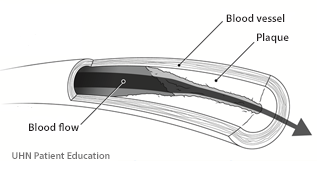Coronary artery disease (CAD) is one of the most common forms of heart disease. It happens when one or more of the arteries of your heart (called coronary arteries) are damaged or diseased and become narrow, stiff, or blocked. These changes in your arteries make it harder for blood to flow through and can prevent your heart from getting enough oxygen-rich blood.
Obstructive CAD

Plaque build-up in the lining of artery
Obstructive CAD is when your arteries become narrow, stiff, or blocked by a process called atherosclerosis. During this process, plaque builds up on the walls of your arteries, leaving less space for blood to flow through to your heart muscle.
The build-up of plaque is slow and can begin as early as childhood. Plaque forms when the lining of your coronary arteries is damaged by risk factors for heart disease (such as high blood pressure, diabetes, smoking, and stress).
Learn more about risk factors for heart disease
Spontaneous Coronary Artery Dissection (SCAD)
Another type of coronary artery disease is called spontaneous coronary artery dissection (SCAD). SCAD is a tear or separation in the wall of your coronary artery. Blood builds up in the artery wall and bulges in a way that narrows or blocks your artery and reduces blood flow to your heart.
SCAD is more common in women than in men. Many people who have SCAD do not have risk factors for heart disease.
Learn more about SCAD:
Resources
